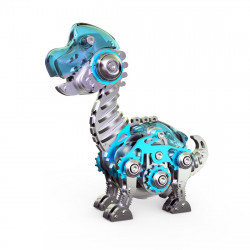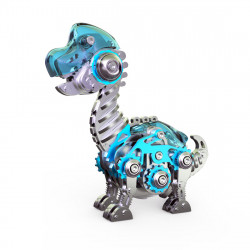Dinosaur Lovers
How much do you know about Tyrannosaurus Rex?
Dinosaurs are most known for their tyrannosaurus rex. Tyrannosaurus Rex has been the subject of research for more than a century, but despite this, fresh findings and studies regarding the dinosaur are reported every year. What is the current state of knowledge regarding Tyrannosaurus Rex?
Canada's most giant Tyrannosaurus Rex
Most Tyrannosaurus Rex fossils are located in the United States, and being the most well-known dinosaur in the country, it has long been associated with the spirit of America.
The fossil of a Tyrannosaurus rex known as "Scotty" was found by an expedition in the French River Valley in southwest Saskatchewan, Canada, in 1991. Following 28 years of study, Canadian paleontologists declared that "Scotty" had surpassed the well-known T-Rex "Su" to become the largest T-Rex ever found. What was the age of "Scotty" the Tyrannosaurus Rex? Paleontologists speculate that it weighed 8800 kg, more than the Tyrannosaurus Rex "Su," and its body length might reach 13 meters. It's unclear who is more significant between "Su" and "Scotty," though, because "Scotty" has a far lower integrity score—65%—than "Su.
Although "Scotty" is not the largest Tyrannosaurus rex, it is still among the largest Tyrannosaurus rex discovered in Canada to date and the most well-known Tyrannosaurus rex.
Since the Tyrannosaurus Rex is a massive animal, as is well known, heat dissipation has emerged as a pressing issue that needs to be resolved. For a considerable time, paleontologists have been aware that Tyrannosaurus rex had two sizable holes on top of its head. These two holes are the supratemporal fenestrae, sometimes called the dorsotemporal fenestra. It conceals the method used by the Tyrannosaurus Rex to dissipate heat. When the temperature was high, the superior temporal foramen of the alligators' heads did not rise. Instead, it fell, and the frontoparietal fossa (Frontoparietal fossa) in front of the superior temporal foramen decreased, according to research done by an anatomy professor at the University of Missouri School of Medicine using a thermal imager. Fossa) has a large number of capillaries that are useful for controlling temperature.
The frontoparietal fossa, a thermostatic structure, is found in all theropods, not just Tyrannosaurus rex, as paleontologists have discovered. The "air conditioners" that come with the Tyrannosaurus Rex are visible through the two large holes on top of its head.
The recently found Tyrannosaurus rex fossil known as "Victoria" was formally displayed at the Arizona Science Center on November 17, 2019. "Victoria" was a 12-meter-long, immature Tyrannosaurus rex between 18 and 25 years old when it perished. Paleontologists discovered the reason for Victoria's demise from the fossils by examining its head and neck. Before he was killed, "Victoria" engaged in a vicious fight with another Tyrannosaurus rex. Its cervical vertebrae and jaw were severely chewed; the mandible even kept the shattered teeth of previous dinosaurs.
Even though she survived the battle, "Victoria" finally lost her life due to terrible septicemia brought on by her wounds. "Victoria" is still being studied, and its finding demonstrates the intense intraspecific rivalry among Tyrannosaurus rex. There appears to be open hostility amongst members of the same species.
Tyrannosaurus rex's tooth change rate
2019 saw the study of Majungasaurus fossils, a carnivorous dinosaur discovered on the island of Madagascar by paleontologists. Based on computed tomography images of Majungasaurus's mouth and an analysis of several preserved shed teeth, scientists found that Majunosaurus had an atypical tooth replacement rate, changing its teeth on average every two months.
Before this study, paleontologists used the tooth-changing frequency and pattern of Tyrannosaurus rex as a model for theropod carnivorous dinosaurs. However, because Tyrannosaurus rex teeth were more robust and more extensive than those of other dinosaurs, tooth changes in these animals required a minimum of two years. Consequently, it is the carnivorous dinosaur whose tooth changes occur least frequently.
Stiff Skull of Tyrannosaurus Rex
Although tyrannosauruses had a powerful biting force, previous studies have suggested that their skulls are somewhat mobile, even as flexible as those of birds and snakes. However, this contradicts the tyrannosauruses' enormous bite force because the force is reciprocal when the skull A tremendous bite force will act on the skull in response to itself, crushing the flimsy skull.
Today's strong-biting animals, including crocodiles and hyenas, have stiff skulls. Using the phylogenetic bracket, paleontologists examined the Tyrannosaurus rex skull and discovered that it was solid in contrast to birds. This is also demonstrated by engineering and anatomical investigation. The "hard" and robust skull of the Tyrannosaurus rex can endure the enormous bite force—more than four tons—that its gigantic mouth produces. This force can rip through the prey's muscles and skin, even breaking bones!
Tyrannosaurus Rex "Su" and Baby Shark
Since its 2000 display at the Field Museum of Natural History in Chicago, Tyrannosaurus Rex "Su" is the most well-known Tyrannosaurus rex fossil.
After clearing the rock around the "Su" skeletal fossil, the museum workers kept the fossil rather than discarding the sand. Using an electron microscope, volunteer Karen Nordquist examined these seemingly worthless sands and discovered some strangely shaped "grit" that was barely 1 mm in size. Paleontologists called the genus Galagadon nordquistae after doing extensive investigation and concluding that the strange "gravel" was, in fact, shark teeth. The name "Small" is derived from a 1981 Namco video game. "Bee" (Galaga).
The known tooth shark is tiny, measuring approximately 0.3 to 0.5 meters long. Its look is strikingly similar to that of the modern baleen shark. It was a little freshwater shark found in lakes and cretaceous rivers. It's possible that the bee-toothed shark gnawed on "Su's" body after it washed into the lake and river, pulling out many of the teeth before they finally fused with "Su's" bones. Fossils that paleontologists have found.
Apart from the previously mentioned study and discoveries concerning Tyrannosaurus rex in 2019, other studies still need to be included. These studies can contribute to our comprehension of the species. We anticipate conducting additional T-Rex studies in the future.
Would you like more information about the past of this once-powerful monster on Earth?

